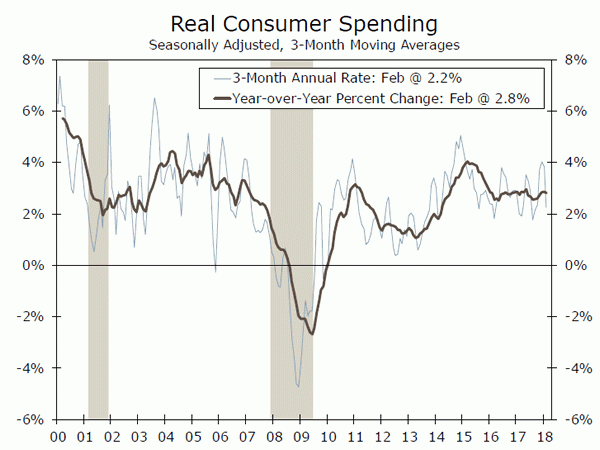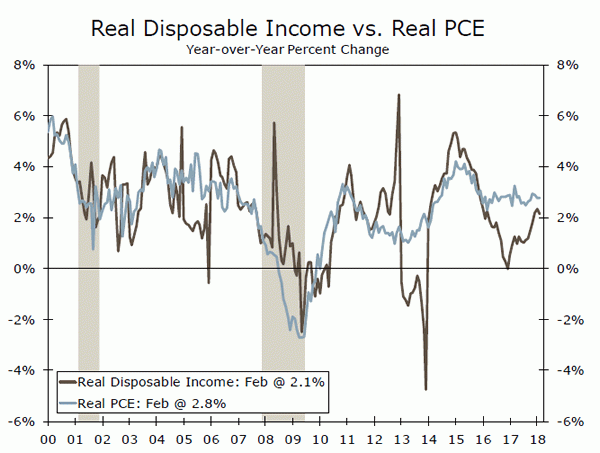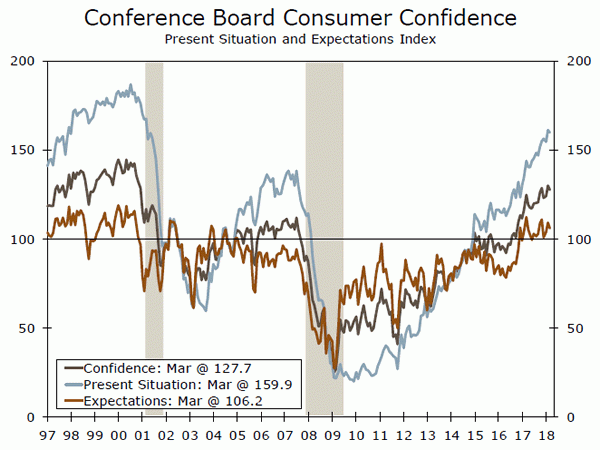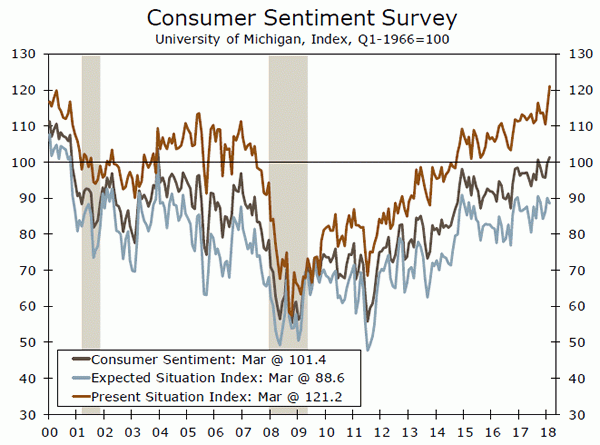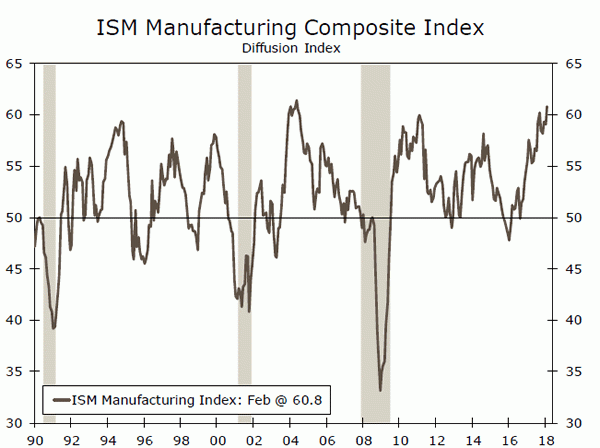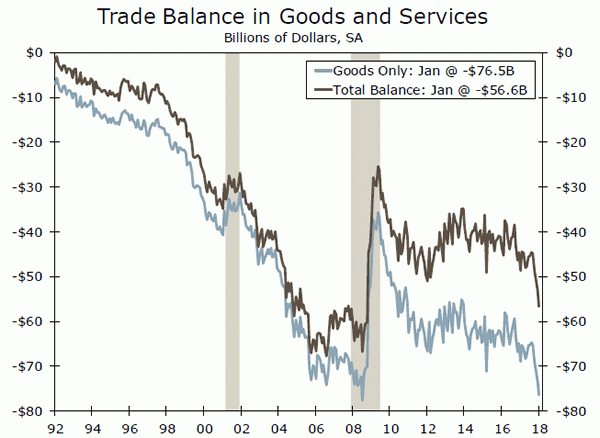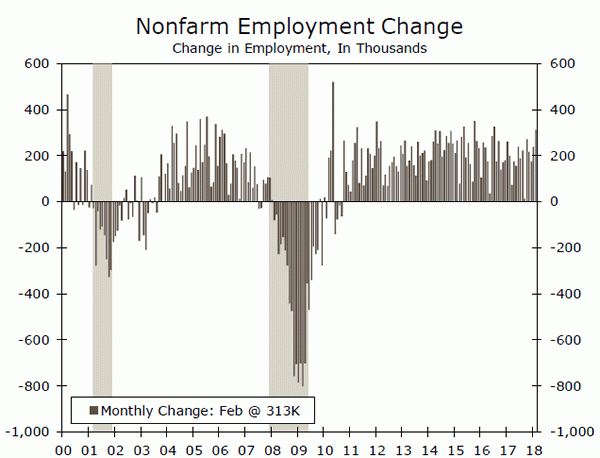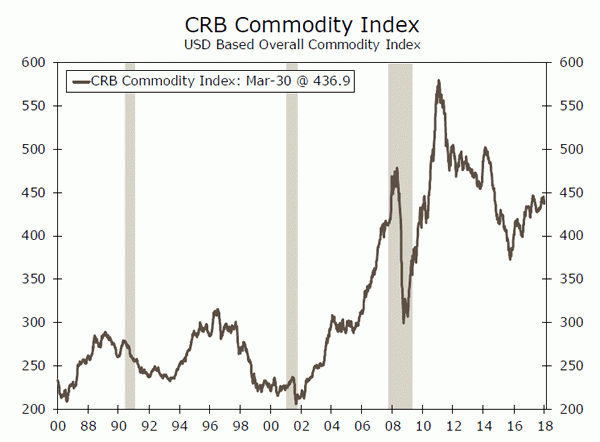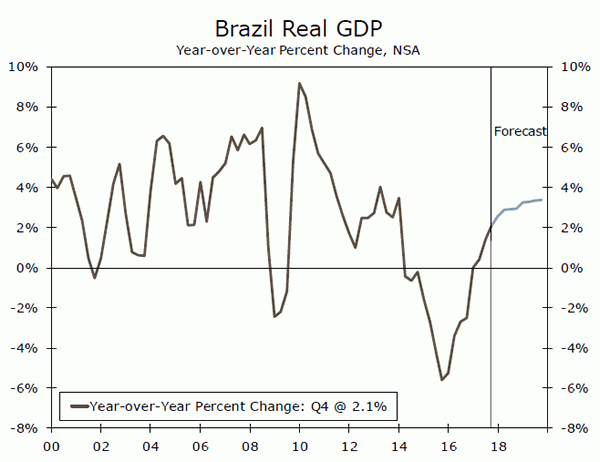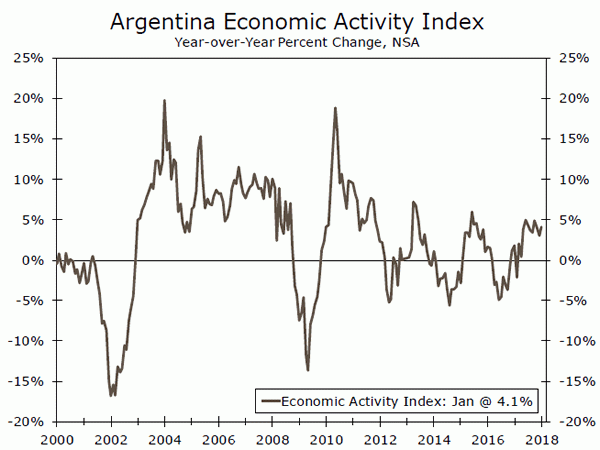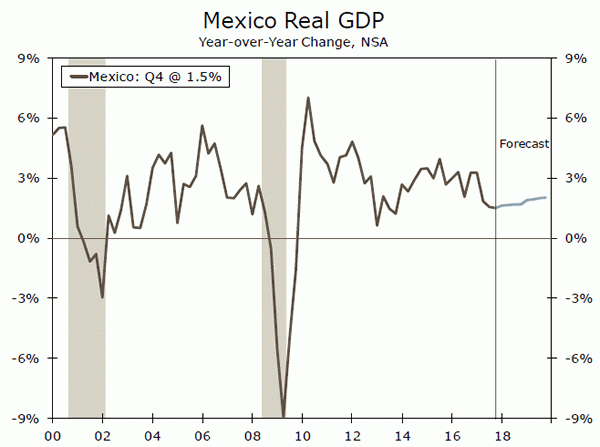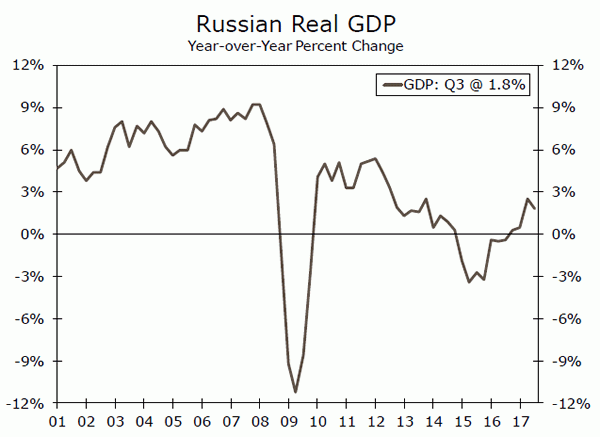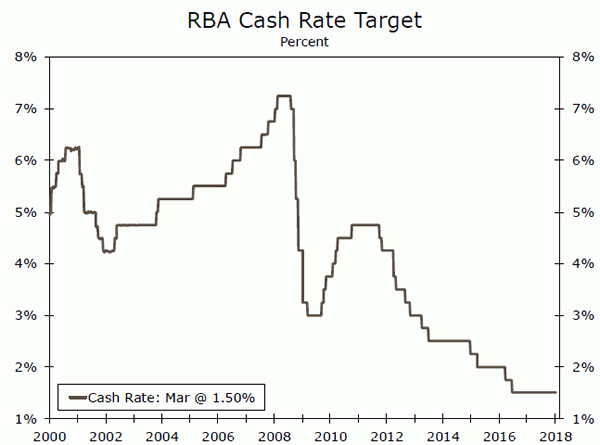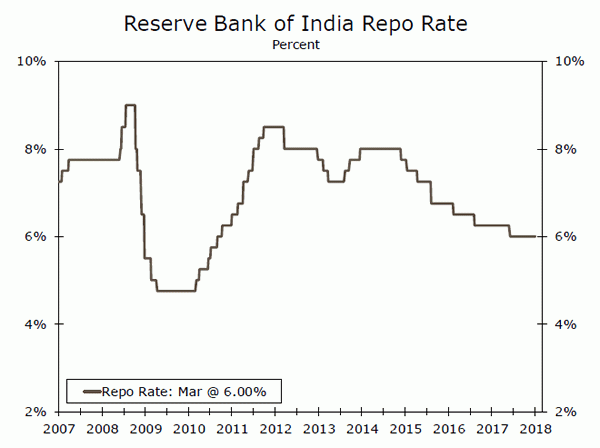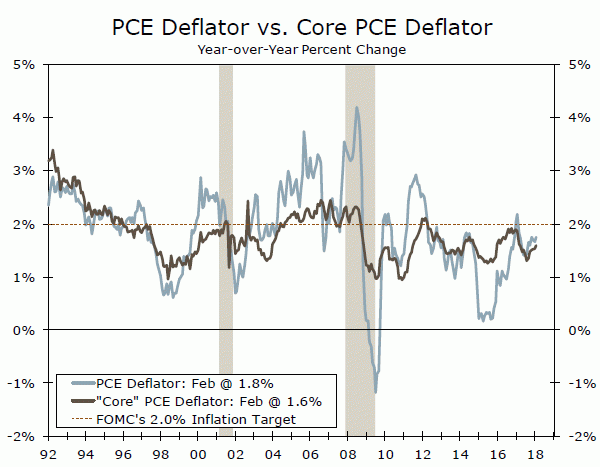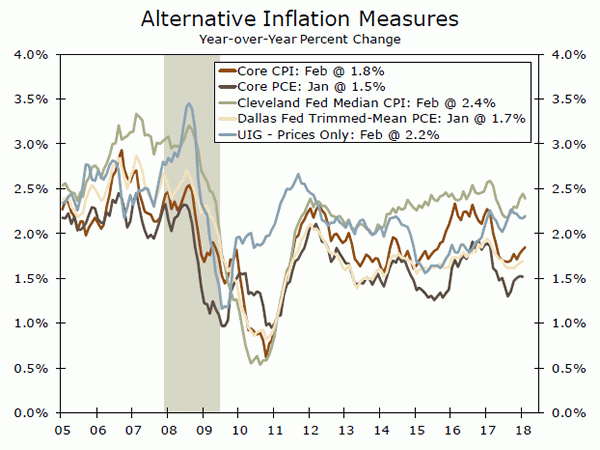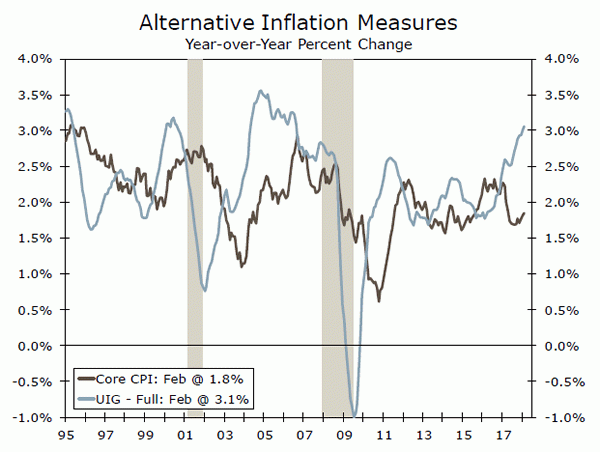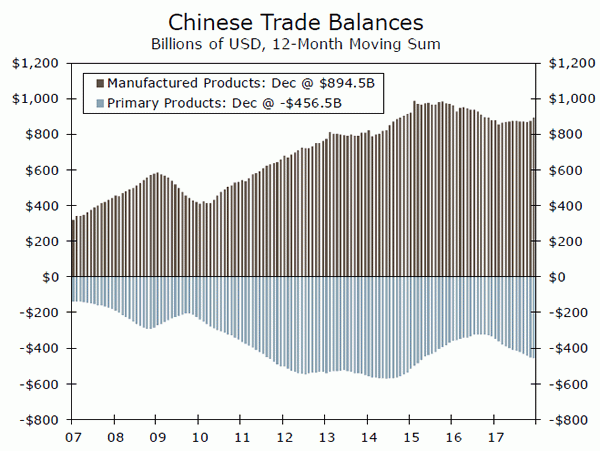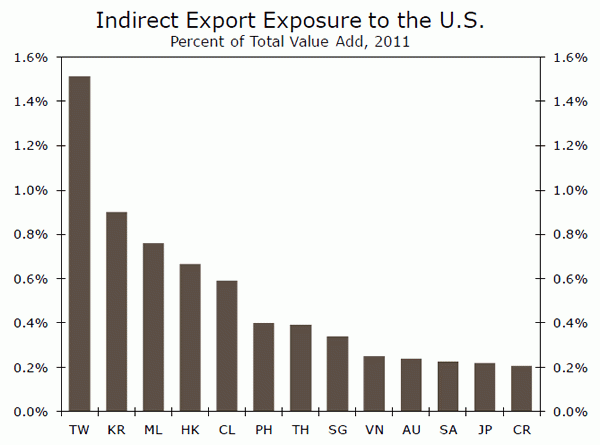U.S. Review
Consumer Spending Takes a Break but Still in the Game
- The economic data calendar largely focused on the consumer this week. The Conference Board’s consumer confidence index cooled slightly from February’s cycle high. The University of Michigan’s measure of consumer sentiment is at a cycle high on upbeat consumers on the lower end of the income spectrum.
- Consumers’ incomes rose solidly in February, but spending has cooled from the breakneck pace in Q4. Although the consumer took a breather and saved more of their income in February, solid fundamentals and continued high sentiment readings suggest a spending rebound in coming months.
Q1 May See PCE Slow but Consumers Still Alright
In a short week for the markets, we learned more about how the consumer fared in recent months. The final look at GDP for Q4 2017 showed U.S. economic growth was 2.9 percent, stronger than the 2.5 percent last reported. Upward revisions to personal consumption showed it rose 4 percent during the quarter, from 3.8 percent previously. The consumer contributed 2.8 points to economic growth at the end of last year on strong gains in goods consumption. However, incoming data from the first few months of 2018 suggest personal consumption expenditure (PCE) growth slowed in Q1. This is not entirely surprising as personal income growth has been slower than what would support such strong spending gains, which the consumer largely accomplished by lowering the saving rate. That consumers chose to borrow against future income growth, or reduce savings, reflects their confidence in the underlying economy. Another reason we believe PCE to be less of a boost in Q1 is because that has largely been the case each year of the current cycle, which likely reflects residual seasonality in the estimates. The recent weather may also depress spending growth, particularly in the northeast.
Personal income growth was solid through February, increasing 0.4 percent for the third straight month. Wage and salary growth has certainly improved recently, as job growth has been strong and the unemployment rate is low, inducing employers to offer more to hire or retain employees. Disposable personal income rose 0.4 percent in February after a large 1 percent gain in January as the effects of tax reform dissipated. Inflation moderated on a month-to-month basis, rising 0.2 percent in February after January’s 0.4 percent rise. Inflation moved higher on a year-overyear basis, however, with the headline PCE deflator rising to 1.8 percent, with core PCE at 1.6 percent. That uptick aligns with expectations that the Fed will see conditions that warrant three more rate hikes this year.
Consumers saved more in February, as spending rose 0.2 percent during the month, which was essentially flat when accounting for inflation. That is an improvement from January, when spending fell 0.2 percentage points after inflation. We expect a rebound in coming months largely because income growth and consumer sentiment remain supportive.
Both surveys of consumer sentiment were positive in March. The Conference Board’s consumer confidence index cooled from February’s cycle high but remains elevated. Consumers’ present situation and expectations moved marginally lower in March due to a slightly less favorable view on business conditions, but they remain upbeat about the strength of the labor market. Consumers’ assessment of business activity may have been negatively affected by uncertainty surrounding trade policy and the return of stock market volatility. That narrative was also evident in the University of Michigan’s consumer sentiment survey, although it still rose further in March to a new cycle high. Income gains from the labor market and tax cuts pushed consumers’ assessment of the present situation to an all-time high. Notably, households in the bottom third of the income distribution drove the increase. Attitudes were lower in March among the top third of households, which cited caution over future economic policy changes, notably on trade.
U.S. Outlook
ISM Manufacturing • Monday
The ISM index recorded another strong month in February signaling broadening business confidence. The headline print of 60.8 was the highest reading the index has shown in more than a decade. Driving the increase was a surge in the employment component of the index, which jumped to 59.7. The prices paid index also increased, which may portend some upward pressure on inflation from the sector later this year. However, with most other components of the index moving into expansion territory, it was yet another positive report reflecting a strengthening manufacturing sector.
While the overwhelming optimism in recent surveys has been remarkable, the sentiment has not been entirely matched with strengthening orders and production data. Recently, core capital goods orders data have been mixed, while production has flat-lined. We will continue to monitor divergence in hard and soft data coming from the manufacturing sector.
Previous: 60.8 Wells Fargo: 60.1 Consensus: 60.0
Trade Balance • Thursday
The U.S. trade deficit widened to $56.6 billion in January, driven primarily by a fall in exports of goods and services. The weak export numbers were mostly attributable to a drop in volatile aircraft exports. Petroleum products also played a starring role in January, as oil-related exports fell 9 percent despite rising oil prices. The value of petroleum imports surged on the month, which largely cancelled out declines in other non-oil imports. The value of overall imports was essentially flat compared to December.
We expect U.S. export growth to be supported in the short term by solid economic growth across the globe and the lagged effects of past dollar depreciation. Strong domestic demand should also boost nonpetroleum imports over the coming months. Although we anticipate some rebound in February, net exports should be a drag on first quarter GDP growth, but not be quite as severe as the final quarter of 2017.
Previous: -$56.6B Wells Fargo: -$56.4B Consensus: -$56.5B
Last month’s above-consensus employment report showed a solid 313,000 addition to payrolls in February. Job gains were widespread, with the information sector being the lone industry to report losses on a three-month moving-average basis. In addition, aggregate hours worked improved 3.1 percent since December, consistent with continued growth in personal income. There was no change to the unemployment rate at 4.1 percent. The labor force participation rate also ticked up to 63 percent; however, the overall trend in labor force growth has slowed compared to recent years.
Rising prime-age workers participation has shown some upward movements lately, yet remains more than a point and a half below its pre-recession level. Unless participation rates continue to rise as solidly as this month, we expect the unemployment rate to decline and payroll growth to moderate over the course of the year as qualified workers become increasingly hard to find.
Previous: 313,000 Wells Fargo: 175,000 Consensus: 189,000
Global Review
Can Latin American Economies Divorce from Politics?
- During our recent trip to South America, visiting Brazil, Argentina, and Peru, we got the impression that something may be changing in Latin America. After the first decade and a half of this century when the region enjoyed an economic boom fueled by strong commodity prices and an almost insatiable demand for these goods by the Chinese economy, more orthodox economic policies seem to be taking hold in the region.
- In Mexico, March 30th marks the start of a presidential campaign, a campaign that promises to shake up markets and add more uncertainty to an economy that has already been negatively affected by the prospects of changes to NAFTA.
Can Latin American Economies Divorce from Politics?
During our recent trip to South America, visiting Brazil, Argentina, and Peru, we got the impression that something may be changing in Latin America. After the first decade and a half of this century when the region enjoyed an economic boom fueled by strong commodity prices and an almost insatiable demand for these goods by the Chinese economy, more orthodox economic policies seem to be taking hold in the region. Furthermore, these good economic times hid one of the region’s eternal problems: rampant corruption. However, after the Odebretch corruption case hit Brazil, and spread all over the region, it seems that not even Latin American politicians remain immune to the new reckoning that is sweeping throughout the region.
Last year, Brazil impeached and ousted Dilma Rousseff while ex- President Lula da Silva is close to starting his 12 year-plus prison sentence, which “may” prevent him from running for president in the upcoming presidential elections. Meanwhile, in Peru, one of the fastest growing economies in Latin America for the past decade or so, the Odebretch scandal has also pushed President Pedro Pablo Kuczynski to resign or face certain impeachment. Ex- President Ollanta Humala and his wife are serving jail sentences for taking bribes from Odebretch, and ex-President Alejandro Toledo is awaiting extradition from the United States and is also facing charges of taking bribes from Odebretch.
Of course, some would say that nothing has changed in Latin America as corruption remains rampant. However, we tend to have a different view: the fact that the justice system in these countries is working and putting ex-presidents in jail is a major departure from the past, which may bring the “fear of punishment” for being corrupt to the forefront, and reduce the propensity to engage in corrupt behavior while in power, which is a big difference from what used to happen in the past. In Argentina, although many of the accused have been let free in the past several weeks, the legal system seems more prone to take over these cases and may also signal a change in levels of impunity that were common in the past.
Meanwhile, the economic reform process, which was abandoned due to the “good economic times” is once again being pursued in an attempt to regain competitiveness in the global economy. Although different countries in the region are in different stages of this process, it is a welcome sign for a region that has been behind in economic growth over the past several years.
Mexican Presidential Campaign Starts to Make Noise
In Mexico, March 30th marks the start of a presidential campaign, a campaign that promises to shake up markets and add more uncertainty to an economy that has already been negatively affected by the prospects of changes to NAFTA. We have not seen this much uncertainty since the break-up of the PRI political monopoly in 2000 when Vicente Fox won the presidency representing the PAN. However, the biggest difference back then was that markets loved what they were seeing. Today, the front runner is Andrés Manuel López Obrador (AMLO) and markets are not loving what they are hearing from him.
Global Outlook
Russia GDP • Tuesday
GDP grew 1.8 percent in Russia in Q3, and the Russian economy is still recovering from negative growth seen in 2015 and 2016 in the wake of the Ukrainian crisis and collapse in oil prices. The outlook continues to remain mixed in recent months. On the one hand, Russian consumers are faring fairly well — the unemployment rate has come down to 5 percent at present and real disposable income grew 4.4 percent in February, likely supporting solid growth in consumer spending. However, growth in industrial production slowed to 1.5 percent year-over-year in February after dropping into negative territory the last two months of 2017, likely weighing on Q4 output. Inflation has also slowed significantly over the past year, at 2.2 percent on a year-earlier basis in February and leading the Central Bank of Russia to cut rates 75 bps since December. Lower inflation and mixed monthly data lead us to see Q4 growth of 2.0 percent in Q4 as the economy continues to recover.
Previous: 1.8% Wells Fargo: 2.0% Consensus: 1.4% (Year-over-Year)
Reserve Bank of Australia • Tuesday
The Reserve Bank of Australia (RBA) left its key lending rate unchanged at its most recent meeting on March 5, and most analysts expect central bank policymakers to remain on hold at Tuesday’s meeting. While economic growth in Australia softened slightly in Q4 to 2.4 percent year over year, domestic demand remained strong amid an improving labor market. However, inflation remains low, and the RBA looks for inflation to only gradually pick up over the next year. Wage growth has also remained lackluster, and was likely a contributing factor to the RBA leaving rates unchanged at its most recent meeting. The RBA’s latest monetary policy statement cited higher overall growth forecasts for 2018, as the global economy generally continues its synchronous upswing started in 2017. The RBA will likely begin to slowly raise rates as soon as the end of this year as long as inflation continues to increase, which should also likely be supportive of stronger wage growth.
Previous: 1.50% Consensus: 1.50%
Reserve Bank of India Meeting • Thursday
While the Reserve Bank of India (RBI) left rates unchanged at its most recent policy meeting on February 7, central bank policymakers have cut the repo rate 200 bps since 2015. Inflation fell below 2 percent in the middle of 2017 as demonetization, rupee appreciation and falling food prices weighed on overall price pressures. However, the Indian economy has since turned around, and GDP grew 7.2 percent in Q4 year over year, surpassing consensus estimates. Fixed-investment spending, government expenditures and industrial output all performed strongly in Q4 and are solid indicators that earlier disruptions caused by demonetization and the roll out of the Goods and Services Tax in mid-2017 have since receded. Inflation also increased to 4.4 percent year-over-year in February, now within the RBI’s 4 percent target. However, the RBI will likely need to see a sustained pickup in inflation and growth before raising rates, and most analysts look for the RBI to remain on hold at next week’s meeting.
Previous: 6.00% Consensus: 6.00%
Point of View
Interest Rate Watch
A Year on From the Cell Plan Shock, Inflation May Be About to Break Out
Inflation has started the year strong. The same could have been said about inflation’s early-year performance last year that brought the Fed’s preferred measure of core inflation within a whisker of 2.0 percent (top chart). It was nearly a year ago, however, that progress ground to a halt.
On a morning where markets were closed in observance of Good Friday, the March CPI report printed an unexpected drop in core inflation. The decline was followed by a string of below-trend prints and drew a fresh round of skepticism over the Fed’s ability to reach its inflation target.
Could it happen again? “Idiosyncrasies” can always pop up, but there are a number of signs that the trend in inflation is moving up. One such sign is the rise in alternative measures of core inflation, which have recovered more convincingly in the wake of last Spring’s slowdown (middle chart). The Trimmed Mean PCE, Median CPI, and Underlying Inflation Gauge (UIG) “prices only” series are all closer to reaching the rates that prevailed last February than the traditional core indices.
More telling may be the New York Fed’s “full” UIG (bottom chart). Rather than simply reorganizing the same price series that make up traditional inflation measures, the UIG incorporates macro and financial variables in an attempt to signal broader price pressures. The UIG “full” series, which leads core CPI by about 16 months, is at its highest rate since summer 2006.
Is the Fed Ready?
With last March’s decline in core inflation making for an easy base comparison, the 12-month readings in traditional core measures are expected to jump. The swift move back toward the Fed’s comfort zone may take markets by some surprise, but the FOMC has already been anticipating such a rebound. Powell noted in his press conference that weak readings would soon be dropping out of the calculations and that inflation appears to be moving toward the Fed’s goal. However, if pressures are building as quickly as the UIG full data set implies, two more rate hikes this year may not be enough.
Credit Market Insights
Mortgage Rates in Lockstep with Fed
This week, the conventional 30-year fixed mortgage rate reached its highest level since January 2014, at 4.69 percent, according to the Mortgage Bankers Association (MBA). Mortgage rates have spiked in recent weeks in the midst of the Federal Reserve hiking interest rates at their March meeting, as well as indicating resolve in its path to normalize interest rates. Despite this upward trend in mortgage rates, mortgage applications continue to slowly increase.
Applications for mortgages for home purchase rose 3.1 percent in the week of the Fed’s rate hike. Over the year, application for purchase have increased 8.2 percent, despite home prices and mortgage rates having significantly increased in that timeframe. Refinance applications are down 10.4 percent from the same period last year. Mortgage rates, according to MBA, have risen 0.74 percentage points since last year. It is likely that homeowners foresaw 2018 bringing increased Fed hikes and mortgage rate increases, and locked in last year’s low rates for refinancing.
Affordability is an issue plaguing the housing market, particularly at lower ends of the pricing scale. As the Fed is poised to continue hiking rates—we expect three more hikes this year—mortgage rates figure to continue rising. At current levels, mortgage rates are unlikely to suppress homebuying demand. However, as home prices continue appreciating, rising mortgage rates could squeeze even more buyers out of the market.
Topic of the Week
Collateral Damage from U.S. Tariffs?
President Trump made headlines this month by announcing tariffs on steel and aluminum imports as well as additional tariffs that are specific to China. Although these measures are probably intended to win trade concessions from foreign economies, it is useful to think about potential consequences if foreign countries should retaliate against the United States.
In this column last week, we analyzed which industries in the United States would be most vulnerable to potential retaliation. We turn our attention this week to analyzing which countries would be most vulnerable to “collateral damage” in an all-out trade war between the United States and China, should one break out. China generally imports raw materials and unfinished products, assembles the inputs and exports finished goods (top chart). Countries that export raw materials and intermediate inputs to China could be indirectly affected if Chinese exports to the United States weakened significantly due to an all-out Sino-American trade war.
Our analysis shows that Taiwan would be the economy with the most to lose from a trade war between mainland China and the United States (bottom chart). Products that are exported from Taiwan to the mainland, assembled into final products and subsequently reexported to the United States account for 1.5 percent of total value added in Taiwan. With the exception of Chile, South Africa and Costa Rica, all the countries with the most indirect export exposure to the United States (via exports to China) are in Asia. That said, none of the countries in the bottom chart, with the possible exception of Taiwan, have so much indirect export exposure to the United States that they would be at serious risk of recession from a Sino-American trade war.




